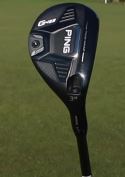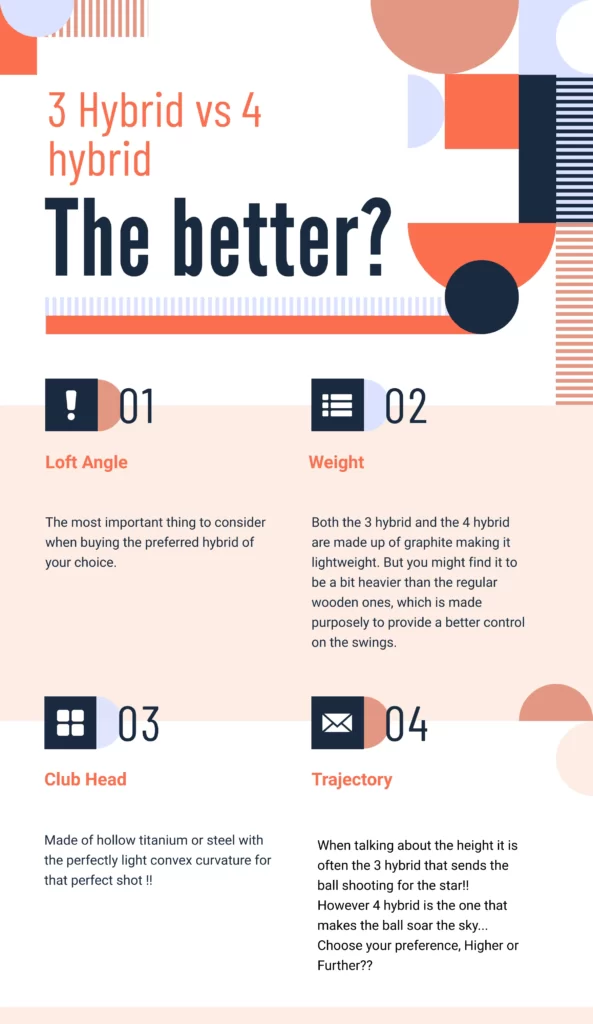3 Hybrid Vs 4 Hybrid: Always Aiming for the Infinity and Beyond

If you are a golf player, you are probably already aware of the debate on 3 hybrid vs 4 hybrid. Golfers often struggle with the long golf clubs, and thus it increases their inclination to purchase the hybrids. The hybrids, be it the 3 hybrid or the 4 hybrids, have better control on the mishits and increase the loft angle. All these increase the likability and popularity among the golfers.
Contents
3 hybrid vs 4 hybrid, the better features?
The choice of hybrid is solely a “personal choice.” Everyone doesn’t need to carry or possess a variety of hybrids. But to address this question of 3 hybrid vs 4 hybrid, let us look into each one individually and understand each feature.
3 hybrid

Let us list down all the features of 3 hybrid to give you a better understanding of this golf club.
- The Loft Angle: This is a crucial thing that one needs to consider while buying a golf club. Also known as “loft,” the loft angles are a degree measurement of the club-heads of the golf clubs’.The loft angle, which is generally found in the 3 hybrids, ranges between 22 degrees to 23 degrees. Such a low value of the loft angle allows the players to launch the ball much higher up in the air and thus cover a larger trajectory. The lower value of the loft angle in the 3-hybrid confirms that the angle is close to the vertical. Thus, the loft being so low in value results in longer shafts.
- Shaft: As already mentioned, the shafts are generally a bit longer in the hybrids when compared with the regular golf clubs. The 3-hybrid shafts are made up of graphite to make it lightweight but a bit heavier when compared with the regular fairway wood. Having a lighter shaft ensures the faster speed of the club-heads.
- The Club-head: When considering the 3- hybrids club-head superficially, it resembles the regular fairway wood golf clubs. In this case, the club-head is generally made up of hollow titanium or steel designed in a convex shape. The convex curvature is specifically designed to ensure “shot correction.” By this term, we mean, this is used to straighten the trajectory of a ball when they are generally hit a bit off the center.
- Distance Covered: The average golfer may anticipate hitting 180 to 240 yards with a 3-hybrid because it replaces the regular 3-iron golf clubs. As a result, golfers may often cover a longer trajectory with these. Hybrid clubs, on average, add 4 to 12 yards to your shot since they are simpler to connect with than standard irons.
4 Hybrid

After learning about the various features of the 3- hybrid, let us now understand the difference that would make if you used the 4-hybrid golf club.
- The Loft Angle: If considering the loft angle of the 4 hybrids compared to the 3 hybrids one, then this one has a higher loft angle value. The angle ranges between 23 degrees and 28 degrees in these hybrids. This value gives the golf club a more horizontal shape. But if you think of this as a disadvantage, it is not. These hybrids hit the ball farther instead of higher as the club-face is oriented more horizontally. Resultingly, there is no sharp fall at the end of the trajectory, and hence the ball does not bounce much.
- Shaft: The shaft of the 4 hybrids ranges between 0.5 to 1 inch, which is longer than the iron ones. However, one can even find clubs as long as 1.25 inches. Like the 3-hybrid, the shaft of this one is also made of graphite. This makes it a bit heavier when compared to the wood golf clubs.
- The Club-head: The 4-hybrid features a hollow titanium or steel club-head with a shallow convex face, as do all hybrid golf clubs. Despite its resemblance to a fairway wood ordinarily available in the markets, the head has an iron-like lie angle, resulting in a flatter sole. Because of the form and design, the club’s Center of Gravity is pushed to the back of the face, making it simpler to send the ball flying, and, as a result, the ball travels farther rather than higher in the sky.
- Distance Covered: If you want to compare the distance the balls cover when hit by a 4 hybrid and a 4 iron golf club, you would be surprised to see that they cover the same distance. But if the comparison is 3 hybrid vs 4 hybrid, the result is slightly different. The ball hit by a 3 hybrid goes higher but the ball hit by a 4 hybrid goes farther.
The Comparison: 3 Hybrid Vs 4 Hybrid
| Parameter | 3-hybrid | 4-hybrid |
|---|---|---|
| Distance Covered | Although the design makes the ball go higher in 3-hybrid, the average distance covered is 190 yards. | The distance covered on average is 180 yards |
| Shaft length | The shafts are longer in hybrids up to 1 inch in 3-hybrid. | Some manufacturers tend to design 4 hybrid shafts for as long as 1.25 inches. |
3 hybrid vs 4 hybrid: How to choose the one?

Well, very honestly, it is challenging to judge the best-suited golf club for you by just reading a comparative study on 3 hybrid vs 4 hybrid. Some golfers believe that they can hit the ball higher up in the sky or have better control over the game by using iron golf clubs.
Again, some players could perform with their 4 hybrids instead of 4 iron in long narrow courses. However, if the comparison is studied between the 3 hybrid vs 4 hybrid it all comes down to the difference in the loft angle and striking distance.
Must Read | Cadet Golf Gloves: For the perfect Tee Off
FAQs Related to 3 hybrid Vs 4 hybrid
Is there an advantage in using hybrids over wood golf clubs?
The hybrid club’s face is more significant than iron but smaller than conventional wood, allowing the player to play the ball in areas where a standard wood could struggle. A ball resting in brutal rough is an excellent example of this. When the hybrid has a good lie, it can be used to hit a ball when a regular wood might fail.
What is the advantage of using a Hybrid golf club over iron?
The hybrid club has a deeper head than a conventional iron, but it is installed on a shaft that looks more like an iron shaft. The head’s center of mass is moved away from the club’s face and closer to the ground as an outcome of this. As a result, the club makes more constant contact with the ball and lifts it off the ground, even with swings.










